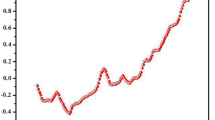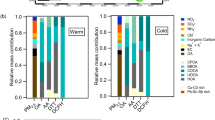Abstract
Determination of emission of contaminant gases as ammonia, methane, or laughing gas from natural ventilated livestock buildings with large opening is a challenge due to the large variations in gas concentration and air velocity in the openings. The close relation between calculated animal heat production and the carbon dioxide production from the animals have in several cases been utilized for estimation of the ventilation air exchange rate for the estimation of ammonia and greenhouse gas emissions. Using this method, the problem of the complicated air velocity and concentration distribution in the openings is avoided; however, there are still some important issues remained unanswered: (1) the precision of the estimations, (2) the requirement for the length of measuring periods, and (3) the required measuring point number and location. The purpose of this work was to investigate how estimated average gas emission and the precision of the estimation are influenced by different calculation procedures, measuring period length, measure point locations, measure point numbers, and criteria for excluding measuring data. The analyses were based on existing data from a 6-day measuring period in a naturally ventilated, 150 milking cow building. The results showed that the methane emission can be determined with much higher precision than ammonia or laughing gas emissions, and, for methane, relatively precise estimations can be based on measure periods as short as 3 h. This result makes it feasible to investigate the influence of feed composition on methane emission in a relative large number of operating cattle buildings and consequently it can support a development towards reduced greenhouse gas emission from cattle production.





Similar content being viewed by others
References
CIGR. (2002). 4th Report of Working Group on Climatization of Animal Houses. CIGR. International Commission of Agricultural Engineering, Section 2. ISBN 87-88976-60-2. 45 pp
INNOVA. (2002). Technical descriptions of gas monitor 1312 and multipoint sampler 1303. Denmark: INNOVA AirTech Instruments A/S.
Kinsman, R., Sauer, F. D., Jackson, H. A., & Wolynetz, M. S. (1995). Methane and carbon dioxide emissions from dairy cows in full lactation monitored over a six-month period. Journal of Dairy Science, 78(12), 2760–2766.
Madsen, J., Bjerg, B. S., Hvelplund, T., Weisbjerg, M. R., & Lund, P. (2010). Methane and carbon dioxide ratio in excreted air for quantification of the methane production from ruminants. Livestock Science, 129(1–3), 223–227. doi:10.1016/j.livsci.2010.01.001.
Ngwabie, N. M., Jeppsson, K.-H., Nimmermark, S., Swensson, C., & Gustafsson, G. (2009). Multi-location measurements of greenhouse gasses and emission rates of methane and ammonia from a naturally-ventilated barn for dairy cows. Biosystems Engineering, 103(1), 68–77.
Pedersen, S., Blanes-Vidal, V., Jørgensen, H., Chwalibog, A., Haeussermann, A., Heetkamp, M. J. W., & Aarnink, A. J. A. (2008). Carbon dioxide production in animal houses: a literature review. Agricultural Engineering International: CIGR Ejournal Manuscript BC 08 008, Vol. X. December, 2008.
Testo. (2011). Testo 174 mini temperature datalogger. Testo AG, Germany http://www.testosites.de/datalogger2011/en_UK/#/174t
Zhang, G., Strøm, J. S., Li, B., Rom, H. B., Morsing, S., Dahl, P., et al. (2005). Emission of ammonia and other contaminant gases from naturally ventilated dairy cattle buildings. Biosystems Engineering, 92(3), 355–364.
Author information
Authors and Affiliations
Corresponding author
Rights and permissions
About this article
Cite this article
Bjerg, B., Zhang, G., Madsen, J. et al. Methane emission from naturally ventilated livestock buildings can be determined from gas concentration measurements. Environ Monit Assess 184, 5989–6000 (2012). https://doi.org/10.1007/s10661-011-2397-8
Received:
Accepted:
Published:
Issue Date:
DOI: https://doi.org/10.1007/s10661-011-2397-8




